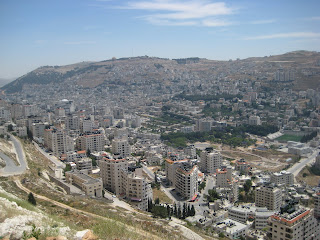
I am now in beautiful Nablus, nestled between Mount Ebal to the north and Mount Gerizim to the south. Today, Friday, is a day of rest, so I spent the day catching up on reading and writing. Walking the empty streets, I notice relics of the city's violent past: some windows punctured with bullets and streets lined with peeling posters of Palestinian martyrs. Contrary to the Western media's depiction, every person killed in the conflict (whether a combatant or a civilian) receives a tribute poster. Nablus was the focus of repeated Israeli incursions during the second Intifada (meaning "shaking off"), when Israeli planes, tanks, and bulldozers targeted the city, killing dozens of civilians and damaging or destroying about 700 buildings. In fact, today is Yom Ha'Atzmaut (Independence Day in Israel) or Al-Naqba ("The Catastrophe" in Palestine), and to remind the city's inhabitants, the Israeli military flew several planes over the city in the morning, breaking the sound barrier. I can see the Israeli army has set up posts in the mountains surrounding the city, and often Palestinians in Nablus will tell me that they always feel as if "we being watched by Israel". During my first evening here, a gentleman sent a plate of fruit to my dinner table and introduced himself as Professor Sa'ed Jamal Abu Hijleh, a Palestinian poet/human geographer/political science professor/radio host/bogger. I don't usually accept fruit from strangers, but I trusted my instincts, and Sa'ed has become a great resource here in Nablus. Despite his exuberant activism, Professor Sa'ed Jamal Abu Hiljeh became extremely emotional when he started to tell me when his mother was killed by Israeli soldiers. In 2002, the 61-year-old grandmother was sitting on her front porch embroidering, when Israeli soldiers opened fire upon them killing her and injuring her husband. There is a memorial website for her here.
No comments:
Post a Comment